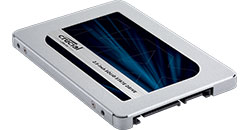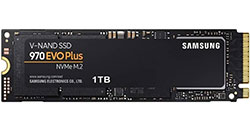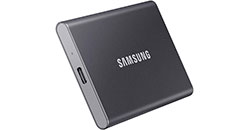Best buy 2.5-inch SATA SSD, M.2 NVMe PCIe SSD and external USB SSD
Crucial MX500
- best buy 2,5″ SATA SSD drive
- 250 GB to 2 TB (2,000 GB)
- up to 560 MB/s read speed
- up to 510 MB/s write speed
- 5 years limited warranty
Samsung SSD 970 EVO Plus
- best buy M.2 NVMe SSD drive
- 250 GB to 2 TB (2,000 GB)
- up to 3,500 MB/s read speed
- up to 3,300 MB/s write speed
- 5 years limited warranty
Samsung Portable SSD T7
- best buy external SSD drive
- 500 GB to 2 TB (2,000 GB)
- up to 1,050 MB/s read speed
- up to 1,000 MB/s write speed
- 3 years limited warranty
shop around for best SSD worldwide on | Amazon.com #ad | computeruniverse.net | eBay.com | AliExpress.com |
- ADS -
Frequently asked questions and answers about SSD drives
What is an SSD?
An SSD, short for Solid State Drive, is an electronic storage medium for computers based on flash memory. An SSD, also known as an SSD hard disk or semiconductor drive, permanently stores data just like a conventional hard disk drive (HDD). On the one hand, an SSD is significantly faster than a magnetic hard disk, but on the other hand the price per gigabyte is higher.
How does an SSD work?
On an SSD, data is stored in the form of electrical charges as 0 and 1 in the memory cells of NAND flash. The controller chip manages the data. The software required for operation, the firmware, is stored on the controller chip.
What is the difference between an SLC, MLC and TLC memory cell?
The difference between the different types of memory cells is the number of electrical states that can be stored: The Single Level Cell (SLC) version takes one bit per cell, Multi Level Cell (MLC) two bits and Triple Level Cell (TLC) three bits. SLC has better write rates than MLC and TLC, but is significantly more expensive to manufacture. MLC and TLC, on the other hand, allow a higher storage density, making SSD hard disks with larger capacities possible. On the other hand, the life span of MLC and TLC memory cells is shorter compared to SLC.
What is the difference between an SSD and a conventional magnetic hard disk drive (HDD)?
The biggest difference between the two drive types is the way they work: While in an HDD the data is stored magnetically on one or more rotating disks (platter), in an SSD it is stored electrically in a variety of flash memory cells. The functional principle of an SSD allows significantly higher transfer rates for reading and writing data and particularly short access times compared to a conventional hard disk. In addition, an SSD has no moving parts of an HDD, which means that the drives operate without noise and vibration.
What are the advantages of an SSD over an HDD?
The higher transfer rates and shorter access times result in several advantages of an SSD compared to an HDD. First of all, the boot times of desktop PCs and laptops are significantly reduced. Programs and applications installed on an SSD start noticeably faster. In addition, locally stored data such as photos, videos and other documents are available more quickly. Due to the absence of mechanical components, SSD hard disks are noiseless and vibration-free. Due to the lower energy consumption, they also generate less waste heat, which is particularly beneficial for use in mobile devices.
What are the disadvantages of an SSD compared to an HDD?
For the buyer, the higher price per gigabyte is the most noticeable disadvantage of an SSD compared to an HDD. In addition, SSD hard disks do not offer the high capacities beyond several terabytes of today’s magnetic hard disks at a price affordable to end users.
Should a new PC or laptop be equipped with an SSD?
Due to the unmistakable advantages, every new desktop PC or new laptop should be equipped with an SSD hard disk. The only reasons against it are a very limited budget or the need for a very large storage at the lowest possible price. In these cases, when buying a new desktop or laptop, one should consider whether an SSD can be retrofitted in the future. Or consider the possibility of achieving the necessary higher storage capacity by adding an additional external drive.
What should you look for when buying an SSD?
Since the budget is usually limited when purchasing a new SSD, the price plays a major role when choosing a new SSD. Whereby also particularly favorable models of well-known manufacturers bring along clear performance advantages compared to conventional HHD. In addition, the prospective buyer should be aware of the sensible memory size or capacity. The existing connections and the possible form factor further limit the choice. In addition, the equipment offered and the manufacturer’s warranty should also be taken into account in the purchase decision.
How do you choose the right size or capacity of a new SSD?
A particularly good guideline for choosing how large a new SSD hard disk should be is the current storage requirement. You can check this simply by taking a look at the current storage medium. If you add up the necessary storage space for the operating system, frequently used programs and applications, as well as for the games to be stored on the SSD, you get a minimum size/capacity for the future drive. It should be noted that in the best case 20 to 30 percent of the SSD will be freed up to ensure smooth operation without performance degradation. Less frequently used data as well as photo, music and video archives can be moved to slower but cheaper internal or external magnetic hard drives.
With which connectors and interfaces are SSD hard drives offered?
Most SSD are offered with a SATA connector, also called Serial ATA. There is also a more compact counterpart, the mSATA connector (mini-SATA), which is mainly used in mobile devices. Since modern SSDs already reach the speed limits of the SATA interface, the M.2 standard has recently become interesting for drives. In addition, SSD storage is offered with the universal PCIe connector (PCI Express), which can be found on every current mainboard for desktop PCs.
What is the difference between a SATA, mSATA, M.2 and PCI Express SSD?
The decisive difference for the buyer is, as the name suggests, the connector used and the form factor of an SSD hard disk drive depending on it. The serial interface SATA, now in its third generation with up to 6 Gigabytes per second (SATA 6Gb/s or SATA III), was originally developed for data exchange of hard disks and other storage media. The format used in SATA SSDs is the 2.5 inch (2.5”) form factor also known from HDDs for laptops and external hard drives. The mSATA connector is the compact version of the SATA interface developed for mobile devices. An M.2 SSD is integrated into the system using the recently introduced M.2 connector. A PCI Express SSD can only be used in a PCIe slot on the motherboard.
What are the advantages of an SSD with SATA, mSATA, M.2 or PCIe connection?
The big advantage of an SSD with SATA connection is the wide distribution of the corresponding interface. All current desktop mainboards, whether in ATX, µATX or Mini-ITX form factor, usually offer several of these slots. Also in many laptops there is a 2.5 inch slot and a Serial ATA connector. The compact mSATA, on the other hand, is more likely to be found in older laptops or ultrabooks and on some older motherboards. The decisive disadvantage of the common specification of SATA and mSATA is the achievable speed.
In the third generation, SATA 6Gb/s, the maximum net data transfer rate is limited to around 600 MB/s (megabytes per second), which means that modern semiconductor drives cannot be further exploited. The M.2 connector, on the other hand, allows SSD hard drives with transfer rates beyond one gigabyte per second. In addition, the particularly compact and space-saving design is one of the advantages of the new interface, making the M.2 SSD even suitable for use in particularly thin Ultrabooks and Laptops. The PCI Express slot also promises to deliver top performance for future SSDs and is already found on all mainboards for desktop and HTPC.
How to find the right connector for the SSD?
Which free port your own computer or laptop offers for the new SSD can often be found out by looking in the manual of the respective device or on the installed mainboard. Relevant internet forums, trade journals or the manufacturer’s website can also help. As long as the budget allows it, one should choose an SSD with the interface that promises the most performance, such as M.2 or PCIe. But a SATA SSD also brings significant performance improvements over an HDD.
Is it possible to connect an SSD with SATA 6Gb/s connector to an older SATA connector?
The SATA interface is basically downward compatible, so you can use a SSD hard disk with SATA III (SATA 6Gb/s) on a SATA II or SATA I connector. However, this does not mean that you can avoid lower speeds and limited performance. Nevertheless, a modern SSD on a SATA II connector works faster than a HDD. Additionally, the backward compatibility works in both directions, so an older SSD with SATA II can also be operated on a current SATA III slot.
What is the difference or the advantage of an expensive SSD compared to a cheap SSD?
An expensive SSD does not necessarily have to be better than a cheap SSD. Although the theoretical read and write speed of an expensive SSD is usually higher than that of a cheap drive, the added value for the normal user is often limited. For the professional user, however, even small differences in performance can have a positive effect on read- and write-intensive tasks, such as copying many and large data and rendering videos. In addition, more expensive SSD hard disks often offer longer warranty periods and more extensive equipment in the form of adapters, brackets and software. Finally, each prospective customer must decide for himself based on the requirements and the available budget whether the additional costs are really worth it.
What advantages do new SSD generations offer compared to older SSDs?
The performance values of SSD with SATA 6Gb/s connection have been stagnating for some time, so upgrading to the latest generation is not absolutely necessary if the currently used SSD is not too old. If your own SSD has been in use for several years, it is worth taking a look at the knowledgeable online portals and the trade press. Compared to SSDs with SATA connection, the latest SSD generations with M.2 or PCIe interface offer significant performance improvements. Upgrading depends on the set budget and own requirements. When buying a new product, however, the prospective buyer should always rely on the most modern SSD.
What should be considered when installing an SSD in a desktop PC?
Before installing a new SSD in a desktop PC, you should check which connectors are available on the mainboard and not occupied. If you are interested in an SSD with a SATA interface, it should be connected to a SATA 6Gb/s connector to avoid performance losses. The SSD hard disk itself can be installed at a free space for hard disks. Depending on the case, an adapter from 3.5 inch to 2.5 inch may be necessary.
Since an SSD works without vibration, decoupling for noise suppression is not necessary. Due to the absence of moving mechanical components, an SSD can be operated in any position, whether vertical or horizontal. If you have higher demands on the performance of an SSD and the mainboard offers an M.2 connector, you can have a look at the corresponding products. M.2 SSDs with PCI Express adapters or PCIe SSDs are an alternative, provided the budget is not too tight.
What is important when installing an SSD in a laptop or ultrabook?
Due to the compact design of laptops and ultrabooks, the choice of connection and installation location is always more limited here than in a desktop PC. If necessary, the already installed 2.5 inch HDD has to make way and free the SATA interface for a faster SSD. Before deciding to buy a 2.5 inch SSD, one should take a look at the laptop’s height and the dimensions of the drive. When choosing the right SSD with the M.2 connector, the right size is also important. For example, an “M.2 2280 SSD” measures 22 millimeters in width and 80 millimeters in length. You can usually find out how much space your own laptop or ultrabook has available in the manual or on the manufacturer’s website on the internet.
What is important when installing an SSD in an HTPC or Media Center PC?
Although the case of an HTPC usually offers more space for an SSD than a flat Ultrabook, you should still take care not to block or disturb the airflow when installing it. In the worst case, reliable cooling is no longer guaranteed, which means that the built-in fans have to be turned up unnecessarily fast and therefore loud, or components may be damaged. In addition, in a HTPC, just like in a desktop or laptop, the choice of the appropriate connection is important.
Should an SSD be actively cooled?
Basically, an SSD does not need active cooling, as it has low energy consumption and therefore generates little heat. However, it can’t hurt if an SSD hard disk in a desktop PC is blown on by the airflow of a case fan, because higher temperatures can have a negative effect on the life expectancy of electronics.
Can an SSD be used as an external drive?
In general, an SSD hard drive can also be used as an external drive, for example in a 2.5 inch hard drive enclosure with USB 3.0 port. However, due to the relatively high price per gigabyte, it would not make much sense to use an SSD as an external and not often used data archive. In addition, the performance capabilities of an SSD are not fully exploited even on a USB 3.0 interface. However, if you want to make regular backups with large data on an external drive, the performance plus of an SSD can save a lot of time. Accordingly, an external SSD would be highly recommended as a drive for data backup.
Should the defragmentation and indexing of the SSD be switched off?
Defragmenting is used to store the related data on the magnetic disk of a conventional hard disk as close together as possible to minimize the frequent alignment of the read and write arm. However, defragmenting an SSD is not necessary, as the way it works is completely different from an HDD. What is advantageous with an HDD is disadvantageous with SSD hard disks, as additional read and write operations are caused unnecessarily. In addition to defragmentation, indexing should also be deactivated on an SSD.
Do I need additional drivers for the SSD under Windows?
Starting with Windows Vista, no additional drivers are required for SATA SSDs that communicate via the AHCI protocol. Before a new installation, the user should ensure that the AHCI mode is activated in the BIOS or UEFI settings under SATA Configuration. A subsequent change requires an intervention in the Windows Registry. The NVME protocol is natively supported on the operating system side since Windows 8, so that no additional driver would actually be necessary here. However, if the M.2 or PCIe SSD does not provide the promised performance, it is recommended to install the driver provided by the manufacturer.
What is AHCI and NVME?
AHCI and NVME are protocols that ensure the software-side communication of SSD drives with their environment. AHCI was developed as a standard for SATA controllers. Since SSD hard drives already reach the performance limits of the SATA connector, the new NVME protocol was developed. The NVME allows the connection of SSDs via the PCI Express interface and thus higher read and write speeds.
Is it possible to operate an SSD in a RAID array and what are the advantages of SSD hard drives in a RAID?
As long as the motherboard offers the appropriate functions, two SSD hard disks, as well as conventional magnetic hard disks, can be combined in a RAID array. In RAID 0 (Stripping), the entire capacity of the two drives is available and the data throughput is almost doubled, because both SSDs can be written to simultaneously. RAID 1 (Mirroring) enables the data on the connected drives to be mirrored to increase reliability. However, the maximum capacity of the smaller connected SSD can be used to store the data.


